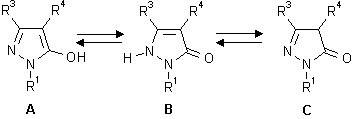Alkylation of pyrazolones via the Mitsunobu reaction
Introduction
N-Substituted pyrazolones can exist in several tautomeric forms, i.e. the OH- (form A), the NH- (form
B) and the CH-isomer (form C)
[1].
Appropriate substituents (for instance COR) in the 4-position of the pyrazole system increase the number of
possible tautomeric forms.
 The alkylation of such ambident compounds can lead to different alkylation products, strongly depending on
the substrate, the alkylating agent and the reaction conditions
[2].
Whereas the application of diazomethane as alkylating agent frequently results in the predominant or exclusive
formation of the corresponding O-methyl derivative, upon reaction of pyrazolones with 'conventional'
alkylating agents such as dimethyl sulfate or alkyl halides often mixtures of O- and N-alkyl
derivatives are obtained. An alternative approach to achieve alkylation of various classes of compounds under
mild and neutral conditions is the Mitsunobu reaction
[3],
which has proved to be a valuable synthetic tool. As, to the best of our knowledge, the application of this
method has not been systematically investigated in the pyrazolone case, we studied the reaction behaviour of 3-
methyl-1-phenyl-2-pyrazolin-5-one and some 4-acyl derivatives thereof under 'Mitsunobu' conditions
(triphenylphosphine, diethyl azodicarboxylate = DEAD, R'-OH, solvent).
The alkylation of such ambident compounds can lead to different alkylation products, strongly depending on
the substrate, the alkylating agent and the reaction conditions
[2].
Whereas the application of diazomethane as alkylating agent frequently results in the predominant or exclusive
formation of the corresponding O-methyl derivative, upon reaction of pyrazolones with 'conventional'
alkylating agents such as dimethyl sulfate or alkyl halides often mixtures of O- and N-alkyl
derivatives are obtained. An alternative approach to achieve alkylation of various classes of compounds under
mild and neutral conditions is the Mitsunobu reaction
[3],
which has proved to be a valuable synthetic tool. As, to the best of our knowledge, the application of this
method has not been systematically investigated in the pyrazolone case, we studied the reaction behaviour of 3-
methyl-1-phenyl-2-pyrazolin-5-one and some 4-acyl derivatives thereof under 'Mitsunobu' conditions
(triphenylphosphine, diethyl azodicarboxylate = DEAD, R'-OH, solvent).







